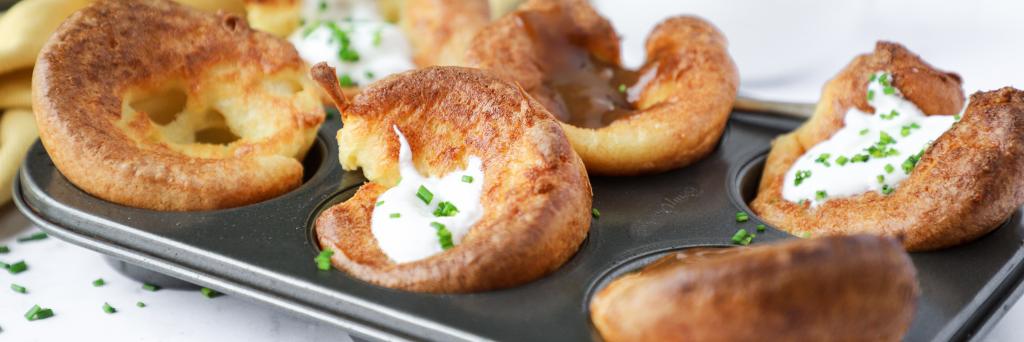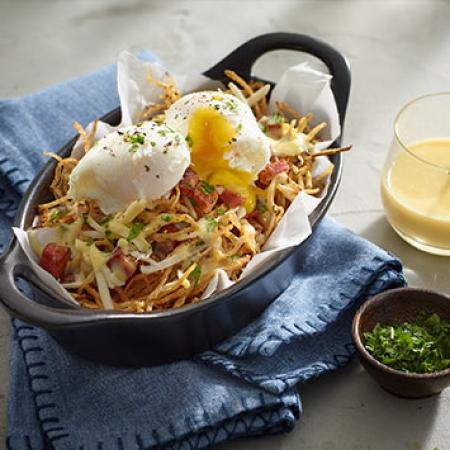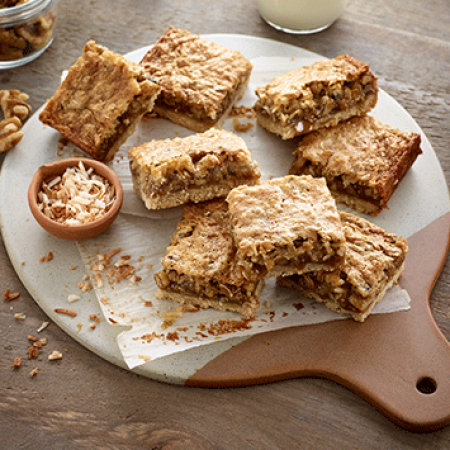Description
Crusty on the outside, fluffy on the inside is the perfect description for this traditional British delicacy. They are an excellent replacement for mashed potatoes when served with roast beef.
Instructions
In large glass measuring cup, whisk flour and salt. Add eggs and milk; whisk until smooth and well blended. Cover and refrigerate for at least 30 minutes.
Preheat oven to 425°F (220°C). Spoon ½ tsp (2 mL) of oil into each cup of a muffin pan. Place pan in oven, on upper third shelf, until very hot and almost smoking, about 13 minutes.
Remove pan from oven and pour batter into muffin cups to about ½ full (it should sizzle) and immediately return to oven. Bake for 20 to 25 minutes or until golden brown and crisp (do not open oven door during baking). Transfer to cooling rack and remove puddings from tray. Serve warm.
Tip: Yorkshire Puddings are also great served as an appetizer or light meal filled with horseradish cream (plain yogurt, prepared horseradish and chopped fresh chives) and smoked salmon or thinly sliced roast beef. These can be made ahead, cooled and frozen in air-tight containers. You can replace vegetable oil with meat drippings when cooking roast beef.
FAQs
Why is it called Yorkshire Pudding?
Yorkshire pudding is a quintessential British dish with a fascinating history behind its name. The origins of the term Yorkshire Pudding can be traced back to Northern England, specifically the county of Yorkshire, where this dish is believed to have originated.
In its early days, Yorkshire Pudding was not the side dish we know today; rather, it was a simple, economical way to make the most of the pan drippings from a roast. Cooks in Yorkshire would pour a batter made of flour, eggs, and milk into the pan while roasting meat, allowing it to cook and rise as the meat roasted. This created a crispy and delicious accompaniment to the roast, which became known as "dripping pudding" or "dripping pancakes" in the 18th century.
Over time, the dish gained popularity and began to be referred to as Yorkshire Pudding, likely due to its association with the region of Yorkshire, where it was a beloved and traditional accompaniment to the classic Sunday roast dinner.
Today, Yorkshire pudding is enjoyed not only in Yorkshire but throughout the United Kingdom and beyond. Its crispy exterior, soft centre, and hearty flavour continue to make it a beloved addition to roast dinners and a favourite comfort food for many.
Are Yorkshire puddings the same as pancakes?
No, Yorkshire Puddings and pancakes are distinct dishes with differences in taste, shape, texture, ingredients, and how they are prepared and served.
Ingredients
Both Yorkshire Puddings and pancakes share a common batter base made from simple ingredients like eggs, flour, and milk. However, the proportions and preparation of the batter differ.
Yorkshire Pudding batter typically has a higher ratio of eggs and flour, resulting in a more substantial and airy texture when baked. The batter is often seasoned with a pinch of salt to enhance its savoury flavour.
Pancake batter, on the other hand, usually contains a higher ratio of milk to create a thinner consistency, which allows for easier spreading in a frying pan or on a griddle. Pancake batter may also include a small amount of sugar for sweetness, making it suitable for various sweet toppings like syrup, fruit, or chocolate.
Cooking Method
Yorkshire Puddings are traditionally baked in muffin tins or a shallow baking dish with a small amount of oil or beef drippings. The batter is then poured into the hot tins and baked in the oven at high temperatures until they puff up and turn golden brown. This baking process gives Yorkshire Puddings their crispy exterior and soft, airy center.
Pancakes, on the other hand, are cooked on a hot griddle or frying pan with a little butter or oil. The pancake batter is poured onto the hot surface and cooked on both sides until golden brown. Pancakes are typically thin and flat with a soft and tender texture throughout.
Serving
The most significant difference between the two lies in how they are served and enjoyed.
Yorkshire Puddings are typically served as a savoury side dish, often accompanying a traditional Sunday roast beef dinner. They are meant to be paired with rich meat and gravy, making them an essential part of a hearty meal.
Pancakes, on the other hand, are versatile and enjoyed in various ways. They can be served with sweet toppings like maple syrup, fruits, whipped cream, or chocolate sauce for a delightful breakfast or dessert option. Additionally, pancakes can also be made savoury and served with fillings such as cheese, vegetables, or meats for a different twist.
What do you eat Yorkshire pudding with?
Yorkshire Pudding is a versatile dish that compliments a variety of meals, but it is most famously enjoyed as an accompaniment to a traditional Sunday roast beef dinner in British cuisine.
Roast Beef Dinner
The most iconic and traditional way to serve Yorkshire Pudding is alongside a roast beef dinner. The rich roast beef pairs perfectly with the crispy and fluffy texture of Yorkshire Pudding. The pudding's hollow center serves as a vessel to hold delicious gravy, adding even more depth to the meal. Yorkshire Pudding elevates the roast dinner experience, making it a beloved part of a hearty and comforting Sunday meal.
Other Meat Dishes
While roast beef is the classic choice, Yorkshire Pudding can also be served with other roasted meats, such as roast chicken, roast pork, or lamb. This is because of the dish's ability to soak up flavourful pan drippings and gravy.
Do you serve Yorkshire pudding hot or cold?
The best Yorkshire Pudding is served hot from the oven on the side of freshly roasted beef.
Although Yorkshire Pudding can be served cold, the texture is not nearly as satisfying as of those pulled from the oven.
Reheating Yorkshire Pudding
If you’re cooking for many and need to prepare your Yorkshire Puddings in advance, you'll be happy to know that Yorkshire Pudding can be chilled in the refrigerator and reheated prior to serving.
Whatever you do, do not reheat the puddings in the microwave as it will cause the exterior to become soft and chewy. The best way to reheat Yorkshire Pudding is in the oven at 400 degrees Fahrenheit (204 degrees Celsius). Place the Yorkshire puddings on a baking sheet and warm them in the oven for about 5-7 minutes or until they are heated through. This will help restore the crispy exterior and soft center, making them taste just as delicious as when they were freshly baked.
Is Yorkshire pudding sweet or savoury?
Unlike pancakes or regular puddings, Yorkshire Pudding is intended to be served as a savoury dish, traditionally alongside a roast beef dinner.
Yorkshire Pudding batter is seasoned with a pinch of salt, which enhances the overall savoury taste and complements the roasted meats and gravies it is traditionally served with.
Furthermore, a classic Yorkshire pudding recipe calls for baking the puddings with meat drippings. When the batter is poured into the hot muffin tins containing beef drippings, it absorbs the flavours in the savoury beef roast.
Other Savoury Pairings
While Yorkshire Pudding is classically served with roast beef, it can also be paired with other roasted meats, such as chicken, pork, or lamb. Additionally, it complements vegetarian roast alternatives and roasted vegetables, making it a versatile addition to your dinners.
What is similar to Yorkshire pudding?
Yorkshire Pudding is made from a simple batter of pantry staples like eggs, flour and milk. While many cultures have their own classic dish made with a similar batter, each recipe has unique characteristics that make the dish its own.
Popovers
Popovers are a popular American dish that bears similarities to Yorkshire Pudding. The batter used in popovers is made from some of the same ingredients as Yorkshire Pudding, like eggs, flour, and milk, and the shape of the finished product is almost identical to Yorkshire Pudding.
However, popovers are typically baked in special popover pans and are sweeter in taste. Because of their sweeter taste, popovers are commonly served as a brunch or breakfast dish that pair well with sweet toppings like fruit, honey, or maple syrup.
Dutch Babies
Dutch babies, or German pancakes, are another dish similar to Yorkshire Pudding. Like Yorkshire pudding, the batter for Dutch babies is poured into a hot skillet and baked until puffed and golden brown.
However, Dutch babies are larger in circumference and have an even, flat width throughout. They are also sweet, as the batter contains sugar and vanilla, lending them nicely to breakfast and brunch meals decorated in sweet toppings like powdered sugar, fresh fruit, and syrup.
What oil is best for Yorkshire pudding?
Traditionally, Yorkshire Pudding is made with rendered beef fat collected from the roast beef it is served with rather than oil. The rendered beef fat helps to create a rich and savoury taste that complements the roast. However, Yorkshire Pudding is often served with a variety of sides that are not necessarily roast beef, which may mean you may not have beef drippings readily available. As a result, our recipe calls for vegetable oil rather than beef fat.
Vegetable oil is an accessible flavourless oil that can withstand high oven temperatures. To maintain a light and neutral taste, you can substitute the vegetable oil in this Yorkshire pudding recipe with any other flavourless oil, like canola oil and sunflower oil.
Should Yorkshire pudding batter be thick or thin?
The ideal Yorkshire Pudding batter should be relatively thin, similar to the consistency of heavy cream or pancake batter. The texture of the batter plays a crucial role in determining the final outcome of the pudding—light, fluffy, and with a crispy exterior.
Here’s how to achieve the perfect consistency:
Proper Ratios
Unlike cooking, baking often requires exact measurements to ensure the batter cooks and rises as intended. Make sure to follow the recipe ratios exactly. If you need to scale the recipe up or down, ensure all ingredients are scaled accurately.
Resting Time
After mixing the batter ingredients, it is beneficial to let the batter rest in the fridge for at least 30 minutes. During this resting period, the flour absorbs the liquids, and the batter thickens slightly. Resting the batter also helps achieve a consistent texture and allows air bubbles to form, contributing to the puffiness of the puddings during baking. Overall, after resting, the batter should still be thinner than typical pancake batter.
Adjusting Thickness
If your batter appears too thick after resting, you can adjust the consistency by adding a small amount of milk or water to achieve the desired thinness. It's essential to add liquids gradually to avoid over-thinning the batter.
Using a Whisk
Using a whisk to mix the batter ensures a smooth and uniform texture. Whisking also incorporates air into the mixture, contributing to the rise of the puddings when baked.
For foolproof Yorkshire Puddings, follow our recipe above!


















